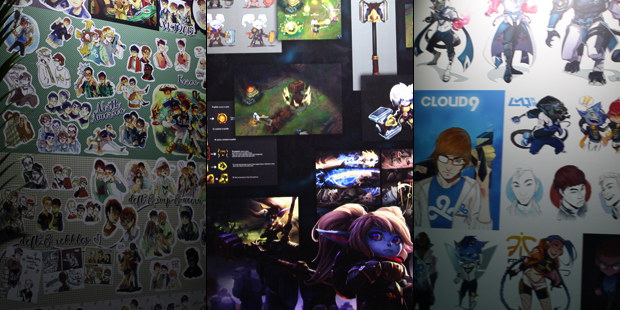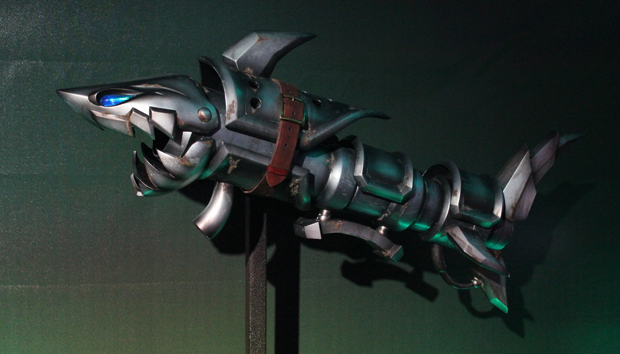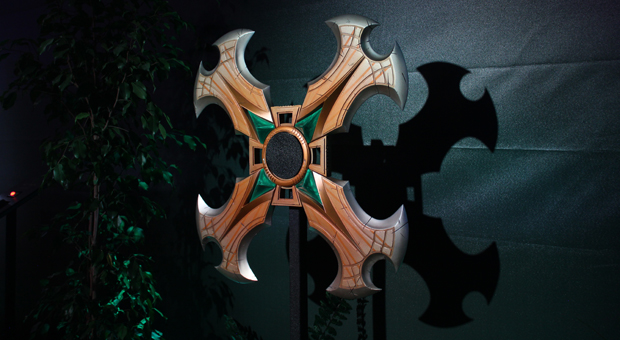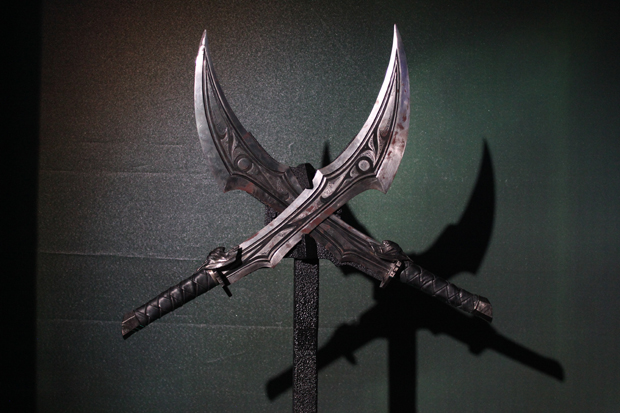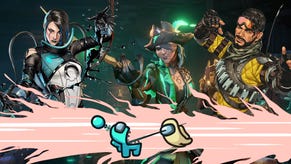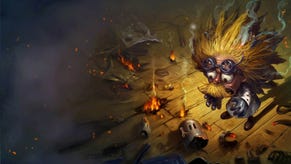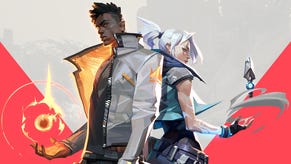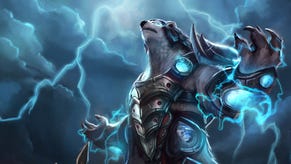The Riftwalk: A quasi-museum for League of Legends
Walking the Rift
As part of their ever-more-complex beast of a roadshow, League of Legends [official site] developer Riot have put together The Riftwalk. It's a physical tribute to their game which converts an area into a kind of curated photo opportunity, showcase and archive which brings together fan creations and official artwork under one roof. So it's a private museum of sorts which pays tribute to the game and rewards fans with a kind of feelgood acknowledgement of a shared enthusiasm.
When I was in LA for the League of Legends 2016 World Championship finals I had a peek at some of the fan events (there was a concert and a cosplay showcase) in addition to the Riftwalk itself situated just outside the Staples Center. My curiosity about the Riftwalk experience and whether Riot were actively archiving their game in any traditional ways were topics I discussed with Jess Frucht who works on Creator Support (the bit of the company that scouts out and builds relationships with great cosplayers, fan artists and the like) and thus has a big hand in the development of The Riftwalk.
I'm just going to pick out some highlights after listening back to our chat and put them in the context of my own thoughts having visited the Riftwalk later. The idea of what we preserve is a topic I come back to a lot with gaming, especially with the rise of living games or games as services. I mean, if you were going to try to preserve League of Legends as an important game or pivotal part of gaming (its reported playerbase alone makes it a curio we might want to salvage to understand more about gaming and audiences at this point in time) where would you even start?
I'll admit that I'm predisposed to thinking about this side of gaming culture because my background is in museums and galleries – an art history degree, volunteer work at my local museum and a job in a library with a historical collection. But I'm not alone in pondering the problem. To take League as the example, would you archive the patch notes? The lore? The video replays of the professional gaming scene? The code itself at two week intervals? The accounts of players explaining what it's actually like at a given point in time?
For the Riftwalk in its LA incarnation there was a space out the front with life-size or larger sculptures of champions and then the Riftwalk itself was a tunnel peppered with set pieces for photo opportunities, replicas of signature weapons, posters with fan art by selected community contributors, official Riot assets showing the development of key characters, and a station at the end for playing the Mechs vs Minions boardgame. As is traditional with museum spaces it funneled you out via a merchandise shop.
I'd say that the overall effect was that the exhibition seemed designed for smaller spaces (which makes sense given it travels around and can't be guaranteed an expanse of land). The posters of fan art in particular seemed dwarfed by the room and couldn't really compete with the interactive opportunities. The light level was also really low when I went which worked for the dramatic costumes or sculptures because they could be bathed in spotlights, but didn't lend itself to reading artist biographies or drawing the eye to their work. It felt like Riot hadn't worked out how to make the 2D/non-interactive contributions shine so they had to play second fiddle to the 3D elements.
The Riftwalk put a particular focus on three champions – Poppy, Sion and Gangplank. Each had received a fairly recent update to their kit, their look or both. This made them good candidates for showcasing the game as an evolving thing because you could offer an effective before and after juxtaposition as well as selected highlights from the period in between.
It's a type of curation and it acted in this case as a shorthand for the game developing and improving over time both in terms of visuals and gameplay.
There was also a Thresh puppet that stands 13 feet tall and can be operated by a human inside.
I saw it uninhabited in the Riftwalk, towering over players who queued for photos, and later had to hurriedly get out of the way as it bore down on me during a live event. That's more of a showpiece which offers a glimpse of how these digital creations can cross over into offline forms. There's a desire to bring these things into being and have them as artifacts or performances which were never part of the original game.
If you go to a League of Legends event you see a lot of cosplayers. I'm used to that by now (and have chatted to people on stilts pretending to be living scarecrows and hidden behind the shield of a muscular hero from LoL's Freljord) although I was a little confused by the number of Harley Quinns at Worlds 2016. Turns out Comic Con was happening next door.
When talking with Frucht, a chap cosplaying as Singed wandered past with some friends. She noted that "the cosplayers are the greatest case in point of this experience of taking something we've created in a digital space [...] and really bringing them into the real world".
Cosplaying takes real work. Sometimes hundreds of hours for particular elements of a character's look and it can be really expensive, too. As per Frucht, people are "spending several paychecks and hundreds of hours to build something they love so much in digital that they want to see it in the real world."
Cosplaying is a fascinating thing in and of itself so I'm not going to attempt to cover it in proper detail here, but the Thresh puppet is joined by further costumes, sometimes inhabited, sometimes displayed as an institution like the V&A might offer up a dress or a prop from a movie. Its inclusion in the Riftwalk feels important because it acts as shorthand again – this time for the fact that this digital thing has crossed over into people's lives in some way. The costumes are created by a tiny proportion of the playerbase but they signify that there's a social dimension to this thing. People create these physical analogues of digital experiences designed to be seen by others. Some are professionals and might form part of a game's own marketing, but with League many come from the player side, unbidden.
Jinx – a wiry character with bright blue hair plaited into these whip-like braids, a manic grin and a rocketlauncher called Fishbones – is a firm favourite with fans. I see blue braids at pretty much every League event I go to and she has a lot of fan art in other formats dedicated to her. But Frucht tells me that monstrous characters like Aurelion Sol and the Kindred also caught the imagination of the community. Beyond that there's, as you might expect, a correlation between characters considered strong in the game and which champions bubble up as trends in the art communities.
Around the corner from the Staples Center is the Grammy Museum which offers a variety of exhibits, interactive elements and performance spaces to try to capture something of the history of music and the history of the Grammy Awards. I'm interested in whether any game companies are toying with the idea of setting up anything similar or whether this kind of work will be left to third parties. If it were to happen I think I'd want there to be a combination of first and third party involvement because a private museum run by the developers or publishers will be rich in terms of assets and access but only needs to tell the story they want to tell. A public museum or a third party would still be telling a story, but could step into more challenging territory, although possibly at the cost of some access.
Companies like CCP for EVE, or Valve for Dota 2 or Riot for League feel like they could theoretically create such archives or museum-adjacent spaces because of the type of games they are as well as the communities they have spawned. But that doesn't mean the studio actually wants to do it. I ask whether there's anything of the kind being spoken of at Riot.
"That's a really interesting question," says Frucht. "My experience has been that we're always trying to find better ways to archive and catalogue all the content that we make and to find ways to help the community archive archive and catalogue all the amazing stuff they make. So we're always working on better ways to do that or organise that.
"Some of the best solutions I've seen are actually community members taking that up through the wikis and all the vast online cataloguing that's being done by players. They do an incredible job. From an art perspective specifically, and looking at the evolution of League and where we are now/where we're going, things like the art book are a great example of us taking time to commit to paper and in digital form this thing we built and how it's grown and changed over the years."
She adds:
"Whether or not we would do a museum-style thing, that's a really cool idea. I haven't heard anything to that effect but I do think it would be really fun to be able to show so much of this. I will say that when you're in the Riftwalk one of the cool things from a museum perspective – there's an armory that shows some beautiful examples of the weapons from League. Lucian's guns, Ziggs' bomb, and a beautiful Leona sword. We call them replicas but they're sort of the originals really."
I really liked this answer because that's a thing I hadn't thought about before; replicas of things that don't exist and how they occupy this really odd position of being an original creation as well as a copy.
There also the armory element here. Armories are a familiar part of so many heritage experiences – I've peered at halberds in the Doge's Palace in Venice, examined ornate flintlock pistols in the Hermitage in St Petersburg and maneuvered my way through collections of deadly pointy objects in the oast house storage facility used by my local museum in Kent – and it's being incorporated in this quasi-museum space of the Riftwalk but without any of these weapons having been used. They're another shorthand, this one referencing the millions of little conflicts being waged and resolved online as well as offering a real-world photo opportunity or showcase for craftsmanship.
I've actually spoken about the act of collecting games with museum and gallery curators. One of those people was Paola Antonelli, senior curator in the Architecture and Design department at the Museum of Modern Art in New York. MoMA made the news when it began collecting videogames as examples of interaction design.
In a snippet for the interview I was doing (the final piece appeared in PC Gamer – that fine, cheery RPS fanzine) Antonelli was talking about the acquisition of SimCity 2000 and explaining that it was chosen for the collection because it best functioned as the crystallisation of the franchise's idea. "Neither the first nor the last but it was where you could really feel you were creating a city." But with games like Minecraft or EVE where the game in question is this slippery, changeable thing the museum was attempting to acquire the relationship with the developer. "You work with the company on how to evolve it, preserve it and how to show it."
I find myself wondering how I would curate League of Legends as a museum exhibition; how to distil elements of the experience and express them in a way that adequately explains this complicated, social, branded juggernaut. It might be a version of the Riftwalk, to be honest, but expanded to contain far more contextual documents/assets/artefacts and with a Chamber of Horrors section to enfold everything an official experience might prefer to gloss.

